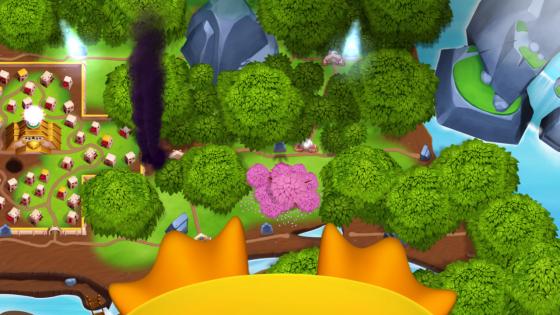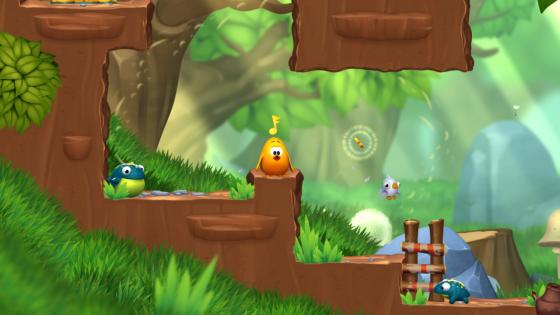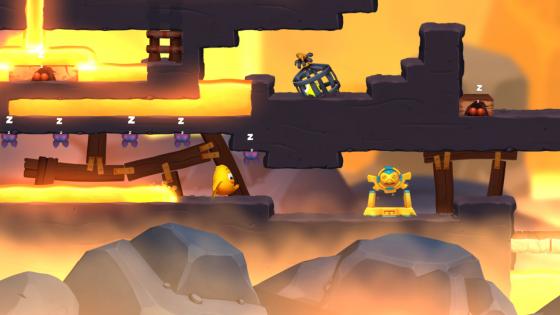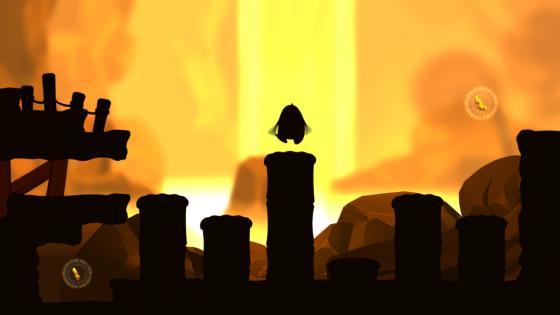
Toki Tori 2 Review
Simple yet effective: three words that sum up Toki Tori 2 perfectly as players traverse levels tweeting and stomping to solve the intricate, yet never too challenging, puzzles that stand between Toki Tori and his ultimate goal. It can never be said that the title is deep but nevertheless it is entertaining with its beautiful art design and plethora of puzzles to solve.
As a chicken, Toki Tori lives a rather unusual life: instead of bumbling around a coop and eating corn, this little fellow decides to move through canyons, mines and forests, scaring and attracting crabs and singing his song of joy wherever he may go. Not contrasting with the games’ ‘story’, there’s a deceptive sense of simplicity about Toki Tori 2, a simplicity that never descends into shallowness and successfully combines complex level designs with the two main principles of the title to create an experience that juggles difficulty with enjoyment to achieve perfection.

In following a principle feature of the game, Toki Tori 2 is visually simple but stunning nonetheless. With a style not too dissimilar from that of the results of an explosion in a paint factory, it’s very difficult not to state that it isn’t a feast upon the eyes. Within seconds, the bright yellow design of the games’ protagonist contrasts sharply with the green and blues of the forest background and as he pleasantly and cheerfully plods his way from one side of the map to the other, it’s impossible not to at least have the corners of the players’ mouths twist upwards into a smile that will no doubt last for the entire duration of the session.
But sometimes, that smile will transform into an unpleasant frown as Toki Tori 2 gradually drifts, like a boat lost in the ocean, from a title of undeniable cuteness to one of sheer frustration as the game suddenly forces the player to see what it is: a puzzler, and what a brilliant one it is at that. It seems a strange comparison, as Valve’s award-winning shooter/puzzler lacks the addition of a bright yellow chicken, but Toki Tori 2 seems to have startling similarities with Portal as it takes a very simple premise and, instead of morphing the games features around the level design, it does the complete opposite, focusing the maps around the player’s two main abilities: stomping on the ground and singing various high-pitched notes.

The main draw of Toki Tori 2 is to get the little chicken from one side of the map to the other, scaring crabs, lighting up dark corners to scare away evil masks or travelling in a bubble spat out by a peculiar frog to reach high areas in the process to do so. Early levels start off deceptively easy, gently easing the player into a state of security before ramping up the difficulty with each level, just enough for it to make it noticeable but at the same time ensuring that it never feels unfair, as the game suddenly and unexpectedly becomes impossible. There are, of course, moments where both the player and Toki Tori reach a dead end, where the components don’t seem to fit together as well as they should do, but regardless of its difficulty, the solution does eventually come (whether that’s with the internet’s assistance or not) and the feeling of success is overwhelming.
Controlling Toki Tori is a consistent joy, regardless of whether reaching the door at the end is as easy as Call of Duty on the lowest difficulty or as impossible as Dark Souls’ toughest moments, and the game never hinders the players progress for only one reason: the players inability to complete the level. If glitches existed then they were as difficult to spot as the titles later missions, and the tantalising way in which the game works gives the impression that the developers are constantly holding a carrot in front of the player, as the solution is always visible but occasionally just out of reach, prompting dedication and resilience in order to see the section to its conclusion.

But like most games, regardless of its positives, Toki Tori 2 is not perfect and a handful of minor flaws keep the game from the small greatness it could be. Instead of presenting the player with countless scrollable text boxes in order to teach those with the controller in their hand what to do and how to do it, it drops Toki Tori in right at the deep end and effectively pushes the player into the big world with the intention of allowing them to work it out for themselves.
Sometimes this is a huge positive as success grants ultimate satisfaction, with the player completing every facet of the level without the gentle prompting of the developers. But in some moments, the absence of a tutorial makes the title ‘too’ difficult as many levels leave the player wandering around without even the first step on the way to success, making the title considerably slower paced than it ever needed to be. To ask for a step-by-step guide of how to do everything in the game is, of course, unnecessary but maybe a small prompter would have assisted considerably. Then again, with Toki Tori 2 being a puzzle title, is even a small hint too much to ask for?

Limited but genuine fun, Toki Tori 2 is probably one the best titles available to download on the Wii U store. The colourful visual style compliments the simplistic elements perfectly and adds a significant steeper learning curve when connected to the absence of a tutorial, yet that also acts as the game’s biggest flaw. In a handful of minutes, Toki Tori 2 shifts unnoticeably from a title of undeniable cuteness to a game of utter beauty and then swiftly into an experience where heads will be scratched, internet searches will exist and all the while, the little chicken whose destiny is to move from door to door in the desire to see bigger and better things stands smiling at the screen, waiting for the player to do something in order to proceed onwards. Thankfully, it’s a grin that both Toki Tori and the gamer will share throughout.
Toki Tori 2 (Reviewed on Nintendo Wii U)
This game is good, with a few negatives.
Limited but genuine fun, Toki Tori 2 is probably one the best titles available to download on the Wii U store. The colourful visual style compliments the simplistic elements perfectly and adds a significant steeper learning curve when connected to the absence of a tutorial, yet that also acts as the game’s biggest flaw.







COMMENTS